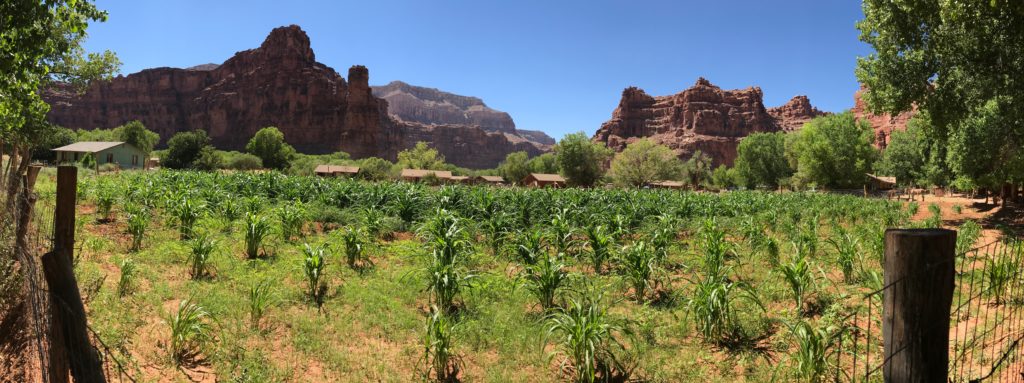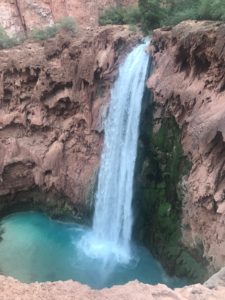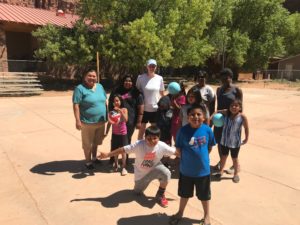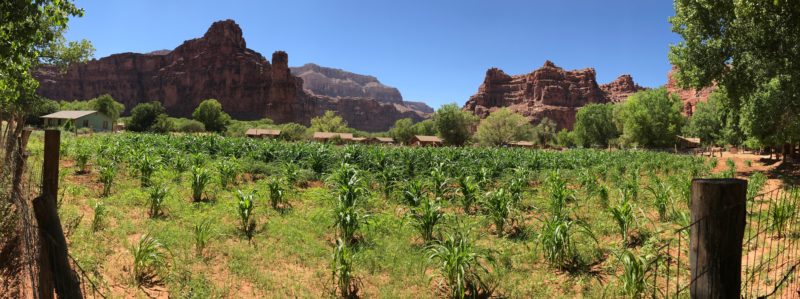When we see people and places in need, do we stop, ask questions, and help? Or do we walk on by, assuming someone else will take care of the problem, hope it will go away, or silently give thanks that we are better off? What problems do you have at your school that can even come close to those faced by one of the most under-served schools in America? Do all problems have solutions? It is easier to ask these questions from the comfort of my own home than when struggling up dusty trails in mid-day sun with 110 degree heat blasting off of red limestone cliffs.

The Havasupai tribe is the most physically isolated group of Native Americans in the Lower 48 states. Several hundred years ago, the Havasupai roamed across vast areas of the south rim of the Grand Canyon. Today, after suffering the genocide of European exploration and American westward expansion, just 250 remaining tribal members live on a few hundred acres of reservation land deep in the canyon of Havasu Creek, a dozen miles south of the Colorado River. I have been to many beautiful and famous spots on our planet, yet few rival the extraordinary natural setting of this ten-mile stretch of desert oasis canyon land.
 Each winter, the tribe opens access to camping permits for tourists who have the stamina and money to visit their tiny slice of natural wonder, a series of gushing waterfalls and travertine pools formed by the clear spring water that have their tribe—“People of the blue-green water”—it’s name. Within 12 hours, the permits for the year are grabbed up: 400 people per day every day of the summer. How big is your own city or town? What if every day this summer, your population nearly doubled with a flock of tourists urgently passing through the town square, just to pitch a tent in the park and swim in your local pool? What problems and issues might that raise??
Each winter, the tribe opens access to camping permits for tourists who have the stamina and money to visit their tiny slice of natural wonder, a series of gushing waterfalls and travertine pools formed by the clear spring water that have their tribe—“People of the blue-green water”—it’s name. Within 12 hours, the permits for the year are grabbed up: 400 people per day every day of the summer. How big is your own city or town? What if every day this summer, your population nearly doubled with a flock of tourists urgently passing through the town square, just to pitch a tent in the park and swim in your local pool? What problems and issues might that raise??
Fortunately, I visited Supai Village with a small team who want to work with the people of the canyon as well as celebrate its natural wonders. I, of course, focused on the five-room K-8 school where we met with the administrators, went on a short “field trip” with the students that was really an excuse to swim in the creek, and gave some quick lessons in volleyball (along with our donation of balls and a net). Here are some of the details about education for the Havasupai children:
- None of the school’s teachers have ever grown up or lived here; all come from the “outside”. Some of the students have had five different teachers in four years; some have had multiple teachers in a single year. It is considered a huge victory if a teacher stays more than two years.
- Most of the students are behind in their learning before they start kindergarten, and never recover. The Head Start program, dormant for years, may finally re-start next year.
- Each teacher is responsible for two grade levels. The school has virtually no resources for students with special needs. In the past, lacking resources, students with special learning needs or discipline issues were just sent home.
- After eighth grade, students have to leave their families to go to high school. Most go to one of five Off-Reservation Boarding schools where Native American kids from around the country go if their tribes do not have their own high schools. The Havasupai high school graduation rate is about 2%.

The students got engaged in a hurry with their new volleyballs!
Amidst the grim statistics are bright lights. The tribe has just built a “computer library” center. There are shelves but no books yet, and an enthusiastic local high school graduate was setting up two computers when we visited. He has no training in technology, but he is doing what he can. The students and teachers at the school have internet connection most of the day, and could learn and collaborate with others outside the canyon…if they knew how to do that. And of course, like almost any other school in the world, the kids are bright and enthusiastic when engaged, and the teachers are hard-working, big-hearted educators who sacrifice a lot to come and work in a place far from their own homes.
Of all the tourists who visit this remarkable canyon, all but a handful walk through the village, stopping only for a cold drink. They make the long hike down from the Rim and back up again to see and sit under the waterfalls and take pictures of scenes so perfectly beautiful that they look like they were built for a theme park. They ignore the fragility of the place; a flash flood in 1993 wiped out most of the village and camping areas; campers fail to haul out their garbage; poverty and poor health care are a constant reminder of how indigenous people struggle to capture even the smallest slice of the American dream. A village of adults and children stay behind and live through the long, blazing summer and cold winters after we have made our whistle-stop visit.
Tourism brings in money each year, but neither money alone or beautiful scenery can square the circle of a small, remote village perched on the border of the past and the future. If high school graduation rates were to rise, would the graduates come home? Or would they leave their families to live in a world where opportunities abound…but at what cost?

Finding a short moment to teach in my first ever “river class”.
There are no easy answers to the problems that the Havasupai face, in education or otherwise. I didn’t write this blog because I have any grand solution, other than to stay connected with the tribal leaders and educators, and see if I might in turn connect them with others. Interested? Let me know. Maybe you and your students have some good learning ideas you can share. And I know for darn sure that the students and teachers of Supai Village have some experiences, traditions, and knowledge that would enrich your lives as well.












Leave A Comment